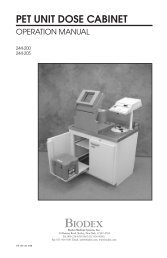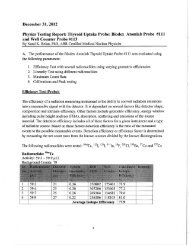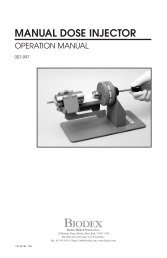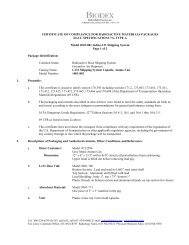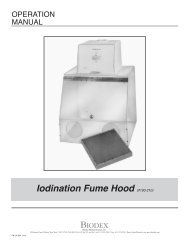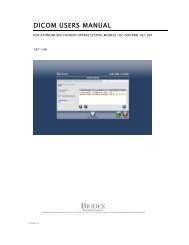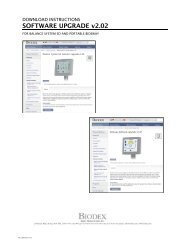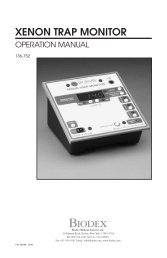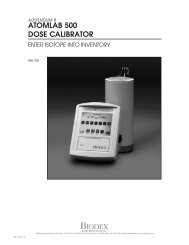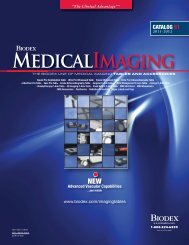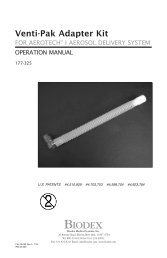Shoulder Dysfunction - Biodex
Shoulder Dysfunction - Biodex
Shoulder Dysfunction - Biodex
Create successful ePaper yourself
Turn your PDF publications into a flip-book with our unique Google optimized e-Paper software.
EVIDENCE BASED CLINICAL PROTOCOL FOR<br />
THE MANAGEMENT OF:<br />
goals:<br />
clinical<br />
evaluations:<br />
clinical<br />
treatment<br />
options:<br />
supervised<br />
program:<br />
home<br />
program:<br />
reports:<br />
post Injury: phase I:<br />
Reduction of Acute Symptoms<br />
• Mentally prepare patient for rehabilitation<br />
• Education of patient to understand the problems of<br />
shoulder dysfunction<br />
• Identify specific needs of patient and<br />
potential problems<br />
• Decrease pain and edema<br />
• Maintain wrist and elbow ROM and strength<br />
• Full PROM (FLEX/EXT ABD/ADD, ER/IR)<br />
• Proprioception: ER < 40% deficit<br />
• Isometric strength: < 50% deficit (all directions)<br />
• Develop voluntary and involuntary control of<br />
shoulder stabilizers<br />
• Correct biomechanical faults<br />
• Identify contributory factors<br />
• General patient history and observation<br />
• Pain scale: location, quality and duration<br />
• Degree and type of edema<br />
• Range of motion: active and passive<br />
• Special tests (instability, impingement, etc.)<br />
• Neurological assessment: myotomes, dermatomes<br />
and reflexes<br />
• Scapulohumoral rhythm<br />
• TEST: <strong>Biodex</strong> bilateral isometric test ER/IR<br />
(modified neutral)<br />
• Rehabilitation process education<br />
• Reduce spasm / pain / edema<br />
• ROM exercises<br />
• <strong>Biodex</strong> passive ER/IR (mod. neutral) 10 deg/sec<br />
• Posture control<br />
• Proprioception:<br />
- PNF patterns<br />
- <strong>Biodex</strong> MJS ER/IR<br />
• Strengthening:<br />
- <strong>Biodex</strong> isometric<br />
(FLEX/EXT, ABD/ADD, ER/IR)<br />
- <strong>Biodex</strong> Closed Chain Attachment<br />
- Scapulothoracic rhythm<br />
• Proprioception: closed chain stabilization<br />
• Cardiovascular training<br />
• Manual grade I oscillations<br />
• Control edema and<br />
manage pain<br />
• Strengthening:<br />
- 4 plane isometrics;<br />
- Elbow, Wrist,<br />
<strong>Shoulder</strong> girdle<br />
- Scapular exercises<br />
- <strong>Shoulder</strong> isotonics<br />
• Flexibility training<br />
• Proprioception Training<br />
• Cardiovascular training:<br />
- <strong>Biodex</strong> LBC/SRC<br />
• Control pain and swelling<br />
• ROM exercises<br />
• Strengthening exercises (isotonic wrist, elbow and<br />
shoulder girdle)<br />
• Cardiovascular training<br />
• Range of motion FLEX/EXT, ER/IR, ABD/ADD<br />
• Pain scale<br />
• Cardiovascular level<br />
• <strong>Biodex</strong> proprioception bilateral comparison:<br />
ER (mod. neutral)<br />
• <strong>Biodex</strong> isometric bilateral comparison:<br />
ER/IR (mod. neutral)<br />
shoulder dysfunction<br />
phase II:<br />
Range of Motion and Initial Strengthening<br />
• Pain free PROM and AROM in all directions<br />
• Decrease pain and edema<br />
• Increase functional activity levels<br />
• Increase shoulder flexibility<br />
• Proprioception: ER (mod. neutral) < 30% deficit<br />
• Isokinetic strength < 50% deficit in all planes<br />
• Increase cardiovascular conditioning<br />
• Develop voluntary/involuntary control of<br />
shoulder stabilizers<br />
• Isometric strength < 50% deficit all planes<br />
• Verify home program compliance<br />
• Scapular winging<br />
• Pain scale: location, quality and duration<br />
• Flexibility testing<br />
• Neurological assessment: myotomes, dermatomes<br />
and reflexes<br />
• TEST: <strong>Biodex</strong> bilateral isometric ER/IR (mod. neutral)<br />
• TEST: <strong>Biodex</strong> bilateral isokinetic ER/IR (mod. neutral)<br />
• TEST: <strong>Biodex</strong> bilateral proprioception ER (90º/90º)<br />
• Reduce spasm / pain / edema<br />
• ROM: AAROM flexion in scapular plane to 90;<br />
AAROM IR; PROM ER<br />
• Postural control<br />
• Strengthening exercises:<br />
- <strong>Biodex</strong> Closed Chain Attachment<br />
- <strong>Biodex</strong> multi-angle isometric (ER/IR, F/E,<br />
ABD/ADD)<br />
- <strong>Biodex</strong> passive mode ER/IR (mod. neutral)<br />
- con/con and con/ecc AAROM<br />
• Proprioception:<br />
- PNF patterns<br />
- <strong>Biodex</strong> ER/IR to 90º/90º<br />
• Closed Chain stabilization exercises<br />
• Cardiovascular training: UBC, LBC, Treadmill<br />
• ROM: pendulum, shoulder bar<br />
• Proprioception<br />
• Cardiovascular Training<br />
• Strengthening:<br />
- 4 way isometrics<br />
- Isotonic elbow FLEX/EXT; wrist FLEX/EXT, UD/RD<br />
- Isotonic scapular musculature<br />
- Isotonic shoulder ABD/ADD<br />
- Isotonic shoulder girdle muscles<br />
• Control pain and edema<br />
• ROM: active and passive<br />
• Strengthening: elbow, wrist, shoulder<br />
girdle musculature<br />
• Cardiovascular training: 20-30 min. 3-4 x/wk<br />
• Proprioception<br />
• ROM<br />
• Pain Scale<br />
• Bilateral comparison: Proprioception ER/IR to<br />
90º/90º<br />
• Bilateral comparison: isometric ER/IR (mod. neutral)<br />
• Bilateral comparison: isokinetic ER/IR (mod. neutral)<br />
• Level of Cardiovascular Fitness



